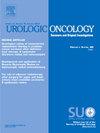THE PROGNOSTIC SIGNIFICANCE OF CIRCULATING TUMOR DNA IN PATIENTS WITH POSITIVE LYMPH NODE DISEASE AFTER ROBOTIC-ASSISTED RADICAL CYSTECTOMY
IF 2.4
3区 医学
Q3 ONCOLOGY
Urologic Oncology-seminars and Original Investigations
Pub Date : 2025-03-01
DOI:10.1016/j.urolonc.2024.12.039
引用次数: 0
Abstract
Introduction
Neoadjuvant therapy followed by radical cystectomy with lymphadenectomy remains the gold standard of treatment in patients with muscle-invasive bladder cancer. Pathologically positive lymph node (pN+) disease is known to convey a poor prognosis. Tumor-informed circulating tumor DNA (ctDNA) has emerged as a possible novel prognostic biomarker in the field. We seek to assess recurrence-free survival (RFS) for patients undergoing robotic-assisted radical cystectomy (RARC) with extended pelvic lymphadenectomy (ePLND) and to assess whether ctDNA status can be a prognostic marker for RFS outcomes in patients with pN+ disease.
Methods
Patients who underwent RARC + ePLND during 2015-2023 were included. A sub-group analysis (n=108) of patients who had prospectively collected serial-longitudinal tumor-informed ctDNA analyses during 2021-2023 was performed. Survival analysis and Cox-regression model were conducted.
Results
Included were 458 patients with a median age of 69 (IQR 63-76), and a median follow-up time of 20 months (IQR 10-37). RFS for pN0 (n=353) and pN+ (n=105) at 12, 24 and 36 months were 87% vs. 55%, 80% vs. 40%, and 75% vs. 36%, respectively (log-rank, p<0.0001). Patients with pN+ disease had similar RFS to patients with pN0 disease if they had undetectable precystectomy ctDNA status (Figure 1A), undetectable postcystectomy ctDNA status (Figure 1B), or among patients that converted from precystectomy detectable to undetectable status at the postcystectomy period (Figure 1C). On Cox-regression multivariate sub-group analysis detectable precystectomy ctDNA status (HR=4.45 [1.55-12.7], p=0.005), and having both ≥pT3 with pN+ disease was predictive of disease recurrence (Table 1A). In the postcystectomy period detectable ctDNA status in the minimal residual disease window (HR=2.89 [1.12-7.4], p=0.028 was predictive of disease relapse (Table 1B).
Conclusions
Patients with pN+ after RARC + ePLND fared worse than patients with pN0 disease. Undetectable ctDNA status was informative of RFS regardless of nodal status at both the precystectomy and the minimal residual disease window. Patients with undetectable ctDNA status and pN+ disease may benefit from treatment de-escalation.
循环肿瘤DNA在机器人辅助根治性膀胱切除术后淋巴结阳性患者的预后意义
新辅助治疗后根治性膀胱切除术加淋巴结切除术仍然是肌侵性膀胱癌患者治疗的金标准。病理阳性淋巴结(pN+)疾病通常预后较差。肿瘤信息循环肿瘤DNA (ctDNA)已成为该领域一种可能的新型预后生物标志物。我们试图评估接受机器人辅助根治性膀胱切除术(RARC)合并扩展盆腔淋巴结切除术(ePLND)患者的无复发生存率(RFS),并评估ctDNA状态是否可以作为pN+疾病患者RFS结果的预后标志物。方法纳入2015-2023年间接受RARC + ePLND治疗的患者。在2021-2023年期间前瞻性收集肿瘤知情ctDNA序列纵向分析的患者进行亚组分析(n=108)。进行生存分析和cox -回归模型。结果纳入458例患者,中位年龄69岁(IQR 63-76),中位随访时间20个月(IQR 10-37)。pN0 (n=353)和pN+ (n=105)在12、24和36个月的RFS分别为87%对55%,80%对40%,75%对36% (log-rank, p<0.0001)。如果膀胱前切除术ctDNA状态无法检测(图1A),膀胱切除术后ctDNA状态无法检测(图1B),或膀胱后切除术期间从膀胱前切除术可检测状态转为不可检测状态的患者,pN+疾病患者的RFS与pN0疾病患者相似(图1C)。cox回归多变量亚组分析显示,膀胱前切除术ctDNA水平可检测(HR=4.45 [1.55-12.7], p=0.005),且pT3≥伴pN+疾病可预测疾病复发(表1A)。在膀胱切除术后,最小残留疾病窗口(HR=2.89 [1.12-7.4], p=0.028)中可检测到的ctDNA状态可预测疾病复发(表1B)。结论RARC + ePLND术后pN+患者预后较pN0患者差。无论膀胱前切除术和最小残留疾病窗口的淋巴结状态如何,未检测到的ctDNA状态都是RFS的信息。ctDNA状态无法检测和pN+疾病的患者可能受益于降糖治疗。
本文章由计算机程序翻译,如有差异,请以英文原文为准。
求助全文
约1分钟内获得全文
求助全文
来源期刊
CiteScore
4.80
自引率
3.70%
发文量
297
审稿时长
7.6 weeks
期刊介绍:
Urologic Oncology: Seminars and Original Investigations is the official journal of the Society of Urologic Oncology. The journal publishes practical, timely, and relevant clinical and basic science research articles which address any aspect of urologic oncology. Each issue comprises original research, news and topics, survey articles providing short commentaries on other important articles in the urologic oncology literature, and reviews including an in-depth Seminar examining a specific clinical dilemma. The journal periodically publishes supplement issues devoted to areas of current interest to the urologic oncology community. Articles published are of interest to researchers and the clinicians involved in the practice of urologic oncology including urologists, oncologists, and radiologists.

 求助内容:
求助内容: 应助结果提醒方式:
应助结果提醒方式:


